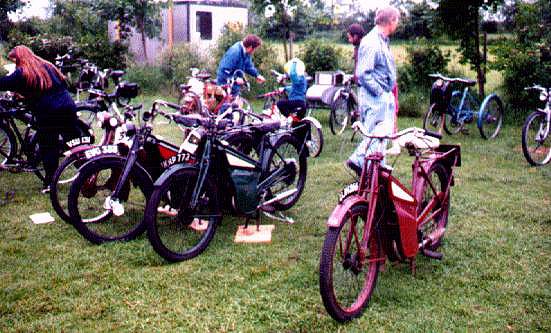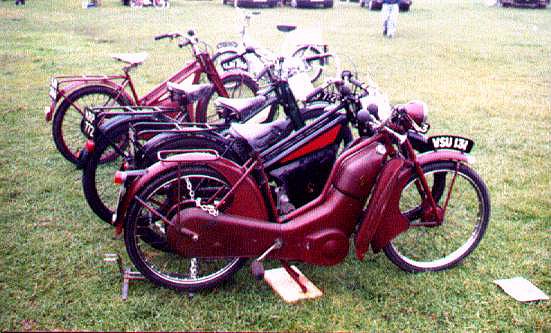 Go
to the Archive index
Go
to the Archive indexNew Hudson built motorcycles from 1903 until the early 1930s, when the company changed to the manufacture of Girling brakes. New Hudson also produced an extensive range of pedal cycles. Early in 1940 they returned to powered two wheelers with an autocycle, but the New Hudson autocycle is chiefly remembered as a post-war machine. This is probably because the later models were the most popular of all the autocycles and New Hudson continued autocycle production much later than any of its competitors did.
The autocycle was launched in March 1940 and was powered by the Villiers JDL engine. It was unsprung and had no engine covers but was otherwise typical of a JDL-powered autocycle. When production recommenced after the war New Hudson had become part of the cycle division of BSA. For 1948, the machine was fitted with pressed steel blade girder forks, plus engine shields and other detail improvements.
The New Hudson was one of the cheapest autocycles available - priced at £48 17s 11d [£48.90] for 1948. In 1949 the New Hudson, in common with other makes of Villiers-engined autocycle, was redesigned to accommodate Villiers’s new 2F engine. The appearance remained much as before, however, as the alterations were hidden by the engine shields. The rest of the cycle parts continued unchanged. In this form, the machine ran on for some years. There were, however, several minor variations in the 2F powered models throughout the years. The initial colour scheme was black with red panels on the fuel tank lined in gold. For 1953 this changed to all green with cream tank panels and the following year to maroon with cream panels. 1955 models reverted to the green colour scheme. The front fork started off with pressed steel blades but these were changed to tubular blades around 1955. There were also variations in handlebars, levers, pedals etc; many of these variations seem to have been determined by the availability of components rather that deliberate design changes.
In May 1956 when the machine was revamped the 2F engine remained as before but the frame was amended to make it easier for the rider to mount. The shape of the fuel tank and the side panels was new and much more modern, while the chains were well enclosed. Both leg shields and a windscreen were available as options.
This “Re-styled” New Hudson was an attempt to update the old design, giving it an appearance more akin to the mopeds that were rapidly taking over from the autocycles. At this time, most of the other makes of autocycle were disappearing from the market in the face of the moped onslaught. The New Hudson continued to be sold until 1958, but that year saw the end of the Villiers 2F engine, so the New Hudson also left the market.
In all, about 24,000 New Hudson autocycles were produced: 5,000 JDL machines, 14,000 of the earlier 2F design and 5,000 “Re-styled models”. New Hudson put their frame numbers on the left-hand rear fork end and each model had its own prefix: MC for the JDL, ZE for the 2F and N for the “Re-styled”.

A row of New Hudson autocycles.
From left to right:
1957 “Re-styled” model,
1951 model (black),
1954 model (green) and
1955 model (maroon)

The next article in this series will describe the Norman and Rambler autocycles.
First published - April 1999